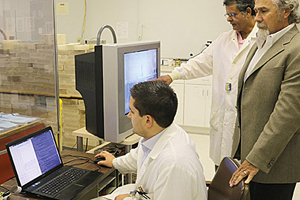|
|
Officials at the Chicago-based startup Sagamore-Adams Laboratories LLC say innovations and discoveries in Purdue University’s Colleges of Engineering & Science are being commercialized for offering the adhesives and sealants industry a “green,” reduced-cost alternative to VOC-based state-of-the-ar. The new technology offers unsurpassed functionality for use in diverse arenas such as for manufacturing automobiles, plywood, particle boards, metal and composite structures, and in home construction.
Sagamore-Adams Laboratories calls the "green" adhesive-sealant PLATech because it is made from non-petroleum-based feedstocks like corn, wheat or sugar cane, and is biodegradable under composting conditions.
Rusi Taleyarkhan, chief technology officer at Sagamore-Adams Laboratories and a Purdue professor of nuclear engineering, says, “Some adhesives and sealants are very toxic, and people might breathe in volatile organic compounds (VOCs) while making and using them.”
Taleyarkhan said PLATech is designed to be safer than conventional adhesives and sealants, to work equally well, and to have a competitive price point.
"By using a variety of techniques that are inclusive of radiation and thermal means we can tailor PLATech’s bond strength, flow rate, set times, water resistance and viscosity for a wide range of applications," he said. "We have found that it is a near-universal adhesive that can coat, seal and adhere to wood, plastics, ceramics, metals (including aluminum to steel), carbon fiber, glass and even Teflon."
The same is true for consumer use of radon detectors. Few homeowners can afford the currently available radon sensors in their homes beyond simple charcoal canisters, despite radon exposure leading to lung cancer and more than 25,000 deaths in the U.S.”
New Technology
Taleyarkhan and other Purdue researchers have developed technology that could lead to radiation sensors that cost less and provide better information than traditional sensors. The technology has been licensed exclusively to Sagamore-Adams Laboratories through the Purdue Office of Technology Commercialization. More than 20 startups based on Purdue intellectual property were launched in fiscal 2014.
Brian Archambault, manager of Production Technology Development, said Sagamore-Adams Laboratories is looking to develop low-cost, efficient and intuitive detectors that allow defense specialists and the general public to see and hear radiation. The technology behaves in a similar way to a stretched rubber band.
“When a rubber band is stretched far enough, it will break upon its own pressure,” he said. “If you stretch the rubber band just below its breaking point and create a small imperfection—with a pin prick, for example—it will break below that level. We do the same thing with fluids: We increase the tension far enough that femto scale, nuclear particles will interact with it and create cavitations, which are liquid-free areas that look and sound like popping bubbles. Our sensors also will be able to tell the directionality of the radiation, so users can not only detect the presence of radiation but also tell where the radiation is coming from. This feature could benefit defense and security personnel.”
Taleyarkhan said Sagamore-Adams Laboratories also is developing radon sensors for homeowners using this technology. “These sensors with tensioned fluid will provide highly accurate results to homeowners within minutes to hours, rather than days and weeks required by traditional systems like charcoal canisters,” he said. “The company’s goal is to have these available for the U.S. market within a few months.”
Sagamore-Adams Laboratories also has developed PLAtech, an adhesive that is made from non-petroleum-based feedstocks like corn, wheat or sugar cane, and is biodegradable under composting conditions.
“Some adhesives and sealants are very toxic, and people might breathe in volatile organic compounds while making them,” he said. “We have created PLAtech to be safer than conventional adhesives and sealants, work equally as well, and have a competitive price point. We can tailor PLAtech’s bond strength, flow rate and viscosity for a wide range of applications. We have found that it is a near-universal adhesive that can coat, seal and adhere to wood, plastics, ceramics, metals, carbon fiber, glass, and even Teflon.”
Sagamore-Adams Laboratories’ technology development has received funding from the U.S. Departments of Defense, Energy, and Homeland Security, as well as the National Science Foundation. The research also was funded by the Purdue Research Foundation-managed Trask Innovation Fund, a development mechanism to assist faculty with work to further the commercial potential of technologies disclosed to the Purdue Office of Technology Commercialization.
Ron Ragains, chief operating officer, said Sagamore-Adams Laboratories believes in the work of Taleyarkhan and Purdue students in his laboratory.
"There are several innovations being developed by Rusi and his students that are filling vacancies in the world, including PLA-based adhesives-sealants and radiation sensors,” he said. “My colleagues and I are involved in commercializing this research because of our confidence and belief in the work these researchers are doing. We are speaking with several industries and prospective company partners about PLATech and sensors."
About Sagamore-Adams Laboratories LLC
Sagamore-Adams Laboratories is a startup research, development and customized product supply business headquartered in Chicago. Its primary objective is to apply its patented technologies to defense, energy, general industrial, commercial and residential applications. For more information, visit http://salabsllc.com.
About Purdue Office of Technology Commercialization
The Purdue Office of Technology Commercialization operates one of the most comprehensive technology-transfer programs among leading research universities in the U.S. Services provided by this office support the economic development initiatives of Purdue University and benefit the university’s academic activities. The office is managed by the Purdue Research Foundation, which received the 2014 Incubator Network of the Year from the National Business Incubation Association for its work in entrepreneurship. For more information, visit www.otc-prf.org.




